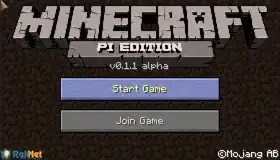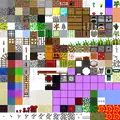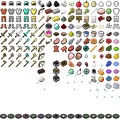Pi Edition

| Author(s) |
Key staff members |
|---|---|
| Platform(s) |
|
| Written in | |
| Latest version |
v0.1.1 alpha |
| Release date |
Unreleased (Alpha: February 11, 2013[2]) |
| Size |
~4 MB |
| License |
Proprietary |
| Source available |
Partial |
| Links |
|
{
"title": "''Minecraft: Pi Edition''",
"rows": [
{
"field": "\n* (link to File:Mojang Studios logo.svg article, displayed as x20px|link=Mojang Studios) (link to Mojang Studios article, displayed as Mojang Studios)\n'''Key staff members '''\n* (link to Markus \"Notch\" Persson article, displayed as Markus \"Notch\" Persson)\n* (link to Aron Nieminen article, displayed as Aron Nieminen)\n* (link to Daniel Frisk article, displayed as Daniel Frisk)",
"label": "Author(s)"
},
{
"field": "(link to File:Raspberry Pi Logo.svg article, displayed as x20px|Raspberry Pi|link=wikipedia:Raspberry Pi)<span style=\"padding-left:4px\">(link to File:Tux.svg article, displayed as x20px|Linux|link=wikipedia:Linux)</span> <small>((link to wikipedia:ARM architecture family article, displayed as ARM) only)</small>",
"label": "Platform(s)"
},
{
"field": "(link to wikipedia:C++ article, displayed as C++)",
"label": "Written in"
},
{
"field": "v0.1.1 alpha",
"label": "Latest version"
},
{
"field": "Unreleased (Alpha: February 11, 2013)",
"label": "Release date"
},
{
"field": "~4 MB",
"label": "Size"
},
{
"field": "Proprietary",
"label": "License"
},
{
"field": "Partial",
"label": "<span style=\"white-space:normal\">Source available</span>"
},
{
"field": "\n* [https://minecraft.net/download#alternate-versions Website]",
"label": "Links"
}
],
"invimages": [],
"images": [
"Minecraft Pi Start Menu.png"
]
}
Minecraft: Pi Edition is an edition of Minecraft developed for the Raspberry Pi. It is a cut down version of Pocket Edition Alpha v0.6.1, containing a revised feature set and support for multiple programming languages. Pi Edition is intended as an educational tool for novice programmers. Given that the Raspberry Pi hardware was relatively slow at the time, this edition was also the only reasonable way to run Minecraft on a Raspberry Pi. Although officially discontinued, it is still available to download for free, from the official downloads page, and users are encouraged to interact with the game using an API.[3]
Pi Edition is no longer updated. Despite this, it was included by default in Raspberry Pi OS (formerly Raspbian).
Gameplay
Pi Edition was very similar to Pocket Edition in many ways. Like older versions of Bedrock Edition, only 256×256×128-block old worlds could be generated. The player's skin is always Steve. The title and the world selection screens were identical until Pocket Edition updated to Pocket Edition v0.7.0 alpha.
The player has the ability to sneak but cannot sprint. Mobs do not spawn, even though the player starts with an iron sword in the hotbar. A bow is also available, but when used, the player holds the bow back indefinitely until they select another item or exit the world.
Pi Edition includes all blocks from Pocket Edition v0.6.1 alpha. The only game mode is creative mode and there is no crafting or smelting.
Biomes
Items
All blocks use old Java Edition textures unless otherwise noted.
 Birch Leaves
Birch Leaves Birch Log
Birch Log Birch Sapling[note 1]
Birch Sapling[note 1] Block of Diamond
Block of Diamond Block of Gold
Block of Gold Block of Iron
Block of Iron Block of Lapis Lazuli
Block of Lapis Lazuli Block of Quartz
Block of Quartz Bookshelf
Bookshelf Bone Meal[note 2]
Bone Meal[note 2] Bow[note 3]
Bow[note 3] Bricks
Bricks Brick Slab
Brick Slab Brick Stairs
Brick Stairs Brown Mushroom
Brown Mushroom Cactus
Cactus Camera[note 4]
Camera[note 4] Chest[note 5][note 6]
Chest[note 5][note 6] Chiseled Sandstone
Chiseled Sandstone Chiseled Quartz Block
Chiseled Quartz Block Clay
Clay Coal Ore
Coal Ore Cobblestone
Cobblestone Cobblestone Slab
Cobblestone Slab Cobblestone Stairs
Cobblestone Stairs Crafting Table[note 5]
Crafting Table[note 5] Cut Sandstone
Cut Sandstone Dandelion
Dandelion Diamond Ore
Diamond Ore Dirt
Dirt Fire[note 7]
Fire[note 7] Furnace[note 5]
Furnace[note 5] Glass
Glass Glass Pane
Glass Pane Glowstone
Glowstone Gold Ore
Gold Ore Grass Block[note 6]
Grass Block[note 6] Gravel[note 6]
Gravel[note 6] Ice[note 8]
Ice[note 8] Info Update
Info Update Iron Hoe
Iron Hoe Iron Sword
Iron Sword Lava[note 9]
Lava[note 9] Ladder
Ladder Melon
Melon Melon Seeds[note 10]
Melon Seeds[note 10] Mossy Cobblestone
Mossy Cobblestone Mossy Stone Bricks
Mossy Stone Bricks Nether Bricks
Nether Bricks Nether Reactor Core[note 5]
Nether Reactor Core[note 5] Oak Door
Oak Door Oak Fence
Oak Fence Oak Fence Gate
Oak Fence Gate Oak Leaves
Oak Leaves Oak Log
Oak Log Oak Planks
Oak Planks Oak Sapling[note 11]
Oak Sapling[note 11] Oak Sign[note 12]
Oak Sign[note 12] Oak Slab
Oak Slab Oak Stairs
Oak Stairs Oak Trapdoor
Oak Trapdoor Obsidian
Obsidian Painting
Painting Red Bed
Red Bed Red Mushroom
Red Mushroom Redstone Ore
Redstone Ore Reserved6[note 13]
Reserved6[note 13] Rose
Rose Sand
Sand Sandstone
Sandstone Sandstone Slab
Sandstone Slab Sandstone Stairs
Sandstone Stairs Smooth Stone Slab
Smooth Stone Slab Snow Block
Snow Block Spruce Leaves
Spruce Leaves Spruce Log
Spruce Log Spruce Sapling[note 14]
Spruce Sapling[note 14] Stone
Stone Stone Bricks
Stone Bricks Stone Brick Slab
Stone Brick Slab Stone Brick Stairs
Stone Brick Stairs Stonecutter
Stonecutter Sugar Cane
Sugar Cane TNT[note 5]
TNT[note 5] Torch
Torch Quartz Pillar
Quartz Pillar Quartz Slab
Quartz Slab Quartz Stairs
Quartz Stairs Water[note 9]
Water[note 9] Wheat Seeds[note 15]
Wheat Seeds[note 15] Wool
Wool
Changes From Pocket Edition v0.6.1 Alpha
- Survival mode is forcibly disabled.
- Opening an existing Survival Mode world loads it in an unusual half-Survival/half-Creative state where some things follow Creative Mode logic while other things follow Survival Mode logic.
- It refuses to join Survival Mode servers.
- The Xperia Play UI is used instead of the normal UI, similar to Pocket Edition v0.1.0 alpha.
- Signs do not open a UI when placed and are always blank unless modified using an external program or modding.
- There is no option to select the world name or seed.
worldis the default name. - There is no option to change LAN server visibility in the pause menu, the LAN world is always visible.
- When playing in a multiplayer world, there is no option to quit and copy the map in the pause menu.
- Just like v0.6.1 alpha the map is still saved as
_LastJoinedServerin the worlds folder. However, it won't show up in the select world screen unless you rename it.
- Just like v0.6.1 alpha the map is still saved as
- A custom cursor is rendered behind the system's mouse cursor.
- The language file included is different than the one included with v0.6.1 alpha.
- There is no sound despite a mute button being in the pause menu.
Development
Release
Minecraft: Pi Edition was originally announced on the Mojang Studios website on November 24, 2012.[4] There was a compiled build labeled 0.1 on the Mojang repository, albeit encrypted until the game's launch in February 2013, making it inaccessible. When it was first uploaded, however, it was unprotected for a short amount of time, allowing for the download of the game before its true release. On December 20, 2012, Mojang Studios released a post on their official site announcing the release of Pi Edition. However, it was promptly removed and no game release was made.
Minecraft: Pi Edition was publicly released in Alpha on February 11, 2013, as version 0.1.1, and the previous release announcement post was restored.[2] However, the Pi Edition website still lists its post date as December 20, 2012.
Addition to Raspberry Pi OS (formerly Raspbian)
On September 15, 2014, the Raspberry Pi Foundation announced that Minecraft: Pi Edition would be installed by default with their new versions of Raspberry Pi OS.[5]
Discontinuation
Pi Edition never received any subsequent updates, and its developers gave no further insights as to whether they were still developing the version. When brought up to Tommaso Checchi on Reddit on January 25, 2016, he stated the following:
| “ |
|
„ |
| — Tommaso Checci on the discontinuation of Pi Edition[6] |
In August 2021, when Raspberry Pi OS Bullseye was released to the public, Pi Edition was officially removed from both the Games Folder and the Recommended Software page because Bullseye dropped support for the graphics API that Pi Edition depended upon.[7] The game is still playable by using a previous version of the operating system. Fortunately, due to advancements in Raspberry Pi hardware, both Java Edition and Bedrock Edition are playable on a Raspberry Pi, albeit potentially requiring some tweaking, depending on the Raspberry Pi model being used.
Trivia
- The player's name is always "StevePi."
- Although there is no survival mode by default, the player can still die by falling in the void.
- All mobs for Pocket Edition v0.6.1 alpha are still in the game's code but they can only be spawned by loading a Pocket Edition map with mobs or by using a nether reactor in a survival map.
- You can download mods to get Survival Mode, as well as other disabled features.[8]
Technical
- You can change the player's skin by editing
data/images/mob/char.png. - It can be re-textured by replacing files in the
datafolder likedata/images/terrain.pnganddata/images/gui/items.png.- When using the Raspberry Pi OS package, the
datais located at/opt/minecraft-pi/data.
- When using the Raspberry Pi OS package, the
- Instead of the normal creative mode, Minecraft: Pi Edition internally uses a "Creator Mode" which appears to be identical except for the API's checkpoints. This is hard-coded, even if the world or server has its data set to survival mode.
- Unlike Pocket Edition v0.6.1 alpha, Pi Edition has its symbols stripped, something Minecraft: Pocket Edition did not do until Bedrock Edition 1.13.0.[9]
- The file
data/lang/en_US.langis included despite the code to load it not being implemented. - It uses Raspberry Pi-specific GPU code preventing it from being easily emulated without modding.
- Textures for Fancy leaves and clouds are included despite Fancy Graphics being impossible to enable without patching.
- The scripting API's Java port includes a class called
pi.Itemdespite the API having no means to interact with items. - Most disabled features are still present in the code like Survival Mode, the Pocket Edition v0.6.1 alpha touch UI, mob attacking, Fancy Graphics, mob spawning, and bow firing.
- It only links against OpenGL ES 2 despite requiring OpenGL ES 1.
Gallery
-
 Minecraft: Pi Edition logo
Minecraft: Pi Edition logo -
 First screenshot of Minecraft: Pi Edition from Mojang's blog.
First screenshot of Minecraft: Pi Edition from Mojang's blog. -
 An image from the removed blog post, appearing to show a recreation of the game Snake.
An image from the removed blog post, appearing to show a recreation of the game Snake. -
 Screenshot of the Minecraft: Pi Edition Inventory
Screenshot of the Minecraft: Pi Edition Inventory -

Textures
See also
Notes
- ↑ Only grows with bone meal.
- ↑ If used on a grass block, only grows flowers as there is no tall grass.
- ↑ Does not fire arrows. Held back indefinitely until the player either logs off or switches to another item.
- ↑ Unused.
- ↑ a b c d e Nonfunctional.
- ↑ a b c Uses the old texture from Pocket Edition v0.6.1 alpha.
- ↑ Invisible and does not spread.
- ↑ Unobtainable.
- ↑ a b Unused.
- ↑ Only grows stem.
- ↑ Only grows with bone meal.
- ↑ Cannot be written on.
- ↑ Used for referencing inventory slots.
- ↑ Only grows with bone meal.
- ↑ Only grows with bone meal.
References
- ↑ "it's in C++" – @danfrisk (Daniel Frisk) on X (formerly Twitter), November 25, 2012
- ↑ a b Minecraft: Pi Edition is available for download!" - Mojang.com; February 11, 2013
- ↑ "Minecraft Pi edition will be free, it's a slightly cut-down version of PE. With added api." – @danfrisk (Daniel Frisk) on X (formerly Twitter), November 24, 2012
- ↑ Minecraft is coming to Raspberry Pi! - Mojang.com; November 24, 2012
- ↑ "New Raspbian and NOOBS releases" by Eben Upton – Raspberry Pi Blog, September 15, 2014.
- ↑ "Is Minecraft: Pi Edition no longer being developed or will there still be updates?" – u/MinecraftOnXP on Reddit, January 24, 2016
- ↑ raspbian - Bullseye: E: Unable to locate package minecraft-pi - Raspberry Pi Stack Exchange
- ↑ Survival Mode Patch – Phirel
- ↑ "THEY REMOVED THE SYMBOLS" – @MisteFr
| |||||||||||||||||||||||
| |||||||||||||||||||||||
| |||||||||||||||||||
| |||||||||||||||||||
| |||||||||||||||||||



